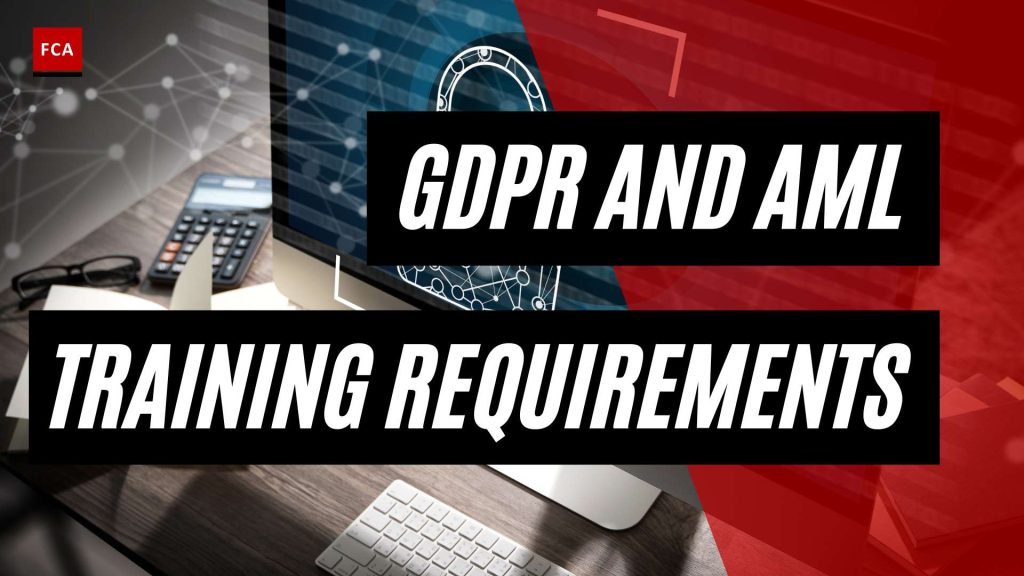Understanding GDPR and AML Training
To ensure compliance with data protection regulations and prevent financial crimes such as money laundering, organizations must prioritize training their employees on General Data Protection Regulation (GDPR) and Anti-Money Laundering (AML) requirements. Understanding the importance and specific training requirements for both GDPR and AML is crucial in maintaining regulatory compliance and protecting sensitive information.
Importance of GDPR and AML Training
GDPR training is essential for employees who handle personal data to mitigate the risk of financial penalties and legal actions in case of non-compliance. The GDPR encompasses a broad definition of personal data, including information about employees, customers, suppliers, and external parties, as well as digital information like IP addresses and metadata (Measured Collective). Regular training sessions on GDPR guidelines help employees understand their responsibilities, reduce the likelihood of data breaches, and demonstrate the organization’s commitment to data protection.
Similarly, AML training is crucial for organizations to prevent money laundering and comply with regulations. Employees need to be educated on recognizing and reporting suspicious activities, as well as the legal obligations and consequences related to money laundering. AML compliance programs are particularly important for banks, fintechs, and financial institutions worldwide to align with regulations such as the Bank Secrecy Act in the U.S. and the EU’s Anti-Money Laundering Directives (Flagright).
Training Requirements for GDPR Compliance
Organizations must ensure that their employees receive GDPR training that is specific to their roles and responsibilities. The UK’s supervisory authority expects organizations to train employees handling personal data, especially data of a special category, before granting access to such data. Additionally, the Data Protection and Digital Information Bill is anticipated to introduce the role of a “Senior Responsible Individual” to oversee training for employees processing personal data (Measured Collective).
GDPR training should cover basic data privacy law, induction and refresher training, specialized roles, monitoring, and awareness-raising. Organizations are advised to keep records of staff training to demonstrate compliance with GDPR’s accountability principle (Measured Collective). Regular refresher training is also recommended to prevent knowledge decay and keep employees updated with changes in data privacy laws.
Training Requirements for AML Compliance
To meet AML compliance requirements, organizations should provide comprehensive AML training to employees. This training should focus on recognizing and reporting suspicious activities, understanding relevant AML laws and regulations, and tailored training for specific roles within the organization. Training programs should address the importance of AML compliance, the consequences of non-compliance, and the role individuals play in preventing money laundering.
Continuous monitoring and audits are essential to ensure the effectiveness of AML training programs. By regularly reviewing and updating training content, organizations can address emerging risks, regulatory changes, and new money laundering techniques. Ongoing training and education are crucial to keep employees informed about evolving AML practices and maintain a strong compliance culture within the organization.
By prioritizing GDPR and AML training, organizations can mitigate risks, maintain compliance with data protection and anti-money laundering regulations, and protect sensitive data. Training employees on these requirements establishes a strong foundation for data privacy and financial crime prevention, ultimately safeguarding the reputation and trust of the organization.
GDPR Training for Employees
To ensure compliance with the General Data Protection Regulation (GDPR) and protect personal data, organizations must provide comprehensive training to their employees. This section explores the key aspects of GDPR training, including an overview of GDPR, its key principles, role-specific training, and the importance of regular refresher training.
Overview of GDPR Training
GDPR training is essential for all staff members who handle personal data, regardless of their role within the organization. The training ensures that employees understand their obligations under the GDPR and are equipped with the knowledge to protect personal data effectively. It covers the fundamental principles of GDPR, legal requirements, and the organization’s specific data protection policies and procedures.
Key Principles of GDPR
GDPR training emphasizes the key principles that form the foundation of the regulation. These principles include:
- Lawfulness, fairness, and transparency: Employees learn about the importance of processing personal data lawfully, ensuring fairness in data handling, and maintaining transparency with individuals whose data is being processed.
- Purpose limitation: Training highlights the necessity of collecting and processing personal data for specified and legitimate purposes.
- Data minimization: Employees understand the significance of collecting and processing only the necessary personal data and avoiding excessive data collection.
- Accuracy: The training emphasizes the importance of keeping personal data accurate, up-to-date, and relevant.
- Storage limitation: Employees learn about the need to retain personal data only for as long as necessary and the requirements for secure data storage and disposal.
- Integrity and confidentiality: GDPR training emphasizes the obligation to implement appropriate technical and organizational measures to protect personal data from unauthorized access, disclosure, alteration, or destruction.
Role-Specific Training for GDPR
To effectively comply with GDPR, training should be tailored to the specific roles and responsibilities of employees. Different employees handle personal data in various ways, and role-specific training ensures that they understand the unique risks associated with their processing activities.
For example, employees involved in customer onboarding may receive training on the secure collection and use of personal data during the onboarding process. Likewise, employees responsible for data storage and access control may receive training on implementing appropriate security measures to protect personal data.
Regular Refresher Training for GDPR
GDPR training is not a one-time event. The Information Commissioner’s Office (ICO) recommends regular refresher training for employees to reinforce their knowledge and keep them up-to-date with changes in regulations, best practices, and potential risks associated with data protection. Refresher training sessions provide opportunities to address any gaps in employees’ understanding of GDPR requirements and reinforce the importance of compliance.
Organizations should conduct periodic assessments to evaluate employees’ knowledge and identify areas that require additional training or clarification. By regularly reviewing and updating the training programs, organizations can ensure that employees remain informed and compliant with GDPR regulations.
By providing comprehensive GDPR training that covers the key principles, role-specific requirements, and regular refresher sessions, organizations can foster a culture of data protection and ensure that employees are equipped with the necessary knowledge to handle personal data responsibly.
AML Training for Employees
When it comes to combating money laundering and ensuring compliance with Anti-Money Laundering (AML) regulations, providing comprehensive training to employees is of paramount importance. AML training educates employees on recognizing and reporting suspicious activities, understanding AML laws and regulations, and tailoring their knowledge to their specific roles within the organization.
Importance of AML Training
AML training plays a vital role in enabling employees to identify and prevent money laundering activities within their organization. By providing employees with the necessary knowledge and skills, organizations can create a strong line of defense against illicit financial activities. A well-trained workforce can actively contribute to the detection and prevention of money laundering, safeguarding the organization’s reputation and integrity.
Recognizing and Reporting Suspicious Activities
One of the key objectives of AML training is to equip employees with the ability to recognize and report suspicious activities. Training should focus on teaching employees how to identify red flags that may indicate potential money laundering, such as unusual transactions, unexplained wealth, or inconsistent customer behavior. By providing clear guidelines and examples, employees can understand their responsibility in reporting suspicious activities to the appropriate authorities within the organization.
Understanding AML Laws and Regulations
AML training should also cover the laws, regulations, and industry best practices related to anti-money laundering. Employees need to have a solid understanding of the legal framework and regulatory requirements that govern AML efforts. This includes knowledge of customer due diligence (CDD), know-your-customer (KYC) procedures, transaction monitoring, and reporting obligations. By ensuring employees are well-versed in AML laws and regulations, organizations can mitigate the risk of non-compliance and potential penalties.
Tailored Training for AML Roles
In addition to providing general AML training for all employees, organizations should tailor training programs to address the specific roles and responsibilities of employees involved in AML-related functions. Different roles may have varying degrees of exposure to money laundering risks and require specialized training to effectively perform their duties. Tailored training ensures that employees understand their specific obligations and can implement AML measures accordingly. This approach enhances the overall effectiveness of the organization’s AML compliance program (Flagright).
By investing in robust AML training programs, organizations can empower their employees to actively contribute to the prevention of money laundering. Regular training sessions, ongoing education, and updates on the latest AML trends are essential to keep employees informed and engaged in the fight against financial crime. Continuous monitoring, independent audits, and periodic reviews of training programs are also critical components in maintaining an effective AML compliance framework (Flagright).
Aligning GDPR and AML Training
Organizations that are subject to both General Data Protection Regulation (GDPR) and Anti-Money Laundering (AML) directives face unique challenges in aligning their training requirements to comply with both sets of regulations. While GDPR focuses on data privacy and protection, AML regulations are aimed at combating financial crimes. Despite their differences in scope and focus, organizations must ensure that their training programs cover the requirements of both GDPR and AML to effectively mitigate risks and maintain compliance.
Challenges in Training Requirements
One of the primary challenges in aligning GDPR and AML training requirements is the differing technicalities and terminology used in each regulation. Organizations need to bridge this gap by developing training programs that address the specific requirements of both GDPR and AML in a coherent and comprehensive manner. It is essential to strike a balance between data privacy and financial crime prevention to ensure that employees understand their responsibilities and obligations under both sets of regulations.
Another challenge lies in the varying levels of expertise and knowledge required for GDPR and AML compliance. While GDPR primarily focuses on data protection and security measures, AML regulations require employees to recognize and report suspicious activities and understand relevant laws and regulations. Organizations must tailor their training programs to cater to the specific roles and responsibilities of employees involved in GDPR and AML compliance.
Strategies for Effective Training
To effectively align GDPR and AML training, organizations can implement several strategies that promote a comprehensive understanding of both regulations. These strategies include:
-
Integrated Training Programs: Developing integrated training programs that cover the requirements of both GDPR and AML can help employees grasp the interconnectedness of data protection and financial crime prevention. By presenting the training material in a cohesive manner, organizations can ensure that employees understand the importance of compliance with both sets of regulations.
-
Role-Specific Training: Providing role-specific training for employees involved in GDPR and AML activities is crucial. This approach allows organizations to address the unique training needs of individuals based on their responsibilities and the risks associated with their roles. By tailoring the training content to specific job functions, organizations can enhance employee engagement and knowledge retention.
-
Continuous Monitoring and Updating: Both GDPR and AML regulations undergo changes and updates over time. To stay compliant and effectively combat risks associated with data protection and financial crimes, organizations must continuously monitor and update their training programs. Regularly reviewing and refreshing the training content ensures that employees are up to date with the latest requirements and best practices.
Continuous Monitoring and Updating of Training Programs
Continuous monitoring and updating of training programs are critical to aligning GDPR and AML training requirements. As regulations evolve and new risks emerge, organizations need to modify their training content accordingly. By regularly assessing the effectiveness of training programs, organizations can identify areas for improvement and address any gaps in knowledge or understanding.
To facilitate continuous monitoring and updating, organizations can establish feedback mechanisms for employees to provide input on the training content and delivery. This feedback can help identify potential areas of confusion or areas where additional training may be needed. Additionally, organizations should stay informed about regulatory developments and industry best practices to ensure that their training programs remain relevant and effective.
By aligning GDPR and AML training requirements and implementing strategies for effective training, organizations can enhance compliance, mitigate risks, and protect the personal data and financial systems they handle. Training plays a crucial role in promoting a culture of compliance and equipping employees with the knowledge and skills necessary to navigate the complex landscape of data protection and financial crime prevention.
Compliance and Record-Keeping
To ensure compliance with both GDPR and AML regulations, organizations must prioritize training and maintain proper records. Compliance with training requirements is essential to demonstrate a commitment to data protection and anti-money laundering measures. This section will delve into the importance of compliance with GDPR training requirements, the significance of training records, the need for reviewing and updating training programs, and the ongoing nature of training and education.
Compliance with GDPR Training Requirements
Under the General Data Protection Regulation (GDPR), organizations are obligated to provide data protection training to all staff members to ensure they understand their obligations. Training should cover the key principles of GDPR as well as the organization’s specific data protection policies and procedures. It is important to tailor the training to the roles and responsibilities of individuals and the risks associated with their processing activities (ICO).
Importance of Training Records
Maintaining comprehensive training records is crucial for demonstrating compliance with GDPR regulations. Organizations should document the content of the training provided, who received it, and when it took place. These records serve as evidence of compliance with GDPR training requirements and can be invaluable in case of disputes or breaches.
Reviewing and Updating Training Programs
Regularly reviewing and updating training programs is essential to ensure that employees remain informed about changes in regulations, risks, and best practices. As both GDPR and AML requirements evolve, organizations should conduct refresher training sessions and assessments to reinforce knowledge and address any gaps identified in employees’ understanding of data protection and anti-money laundering requirements. This ongoing commitment to training helps organizations adapt to emerging risks and maintain compliance (ICO).
Ongoing Training and Education
Training programs for GDPR and AML should not be viewed as a one-time exercise. It is crucial to provide regular training and updates to employees to promote a culture of compliance and data protection awareness throughout the organization. Ongoing training and education ensure that employees stay up-to-date with the latest regulatory requirements, industry best practices, and emerging risks. This continuous learning approach helps organizations mitigate risks and uphold their commitments to data protection and anti-money laundering efforts (ICO).
By maintaining compliance with GDPR training requirements, prioritizing training records, regularly reviewing and updating training programs, and providing ongoing training and education, organizations can foster a culture of compliance and data protection. These practices not only help meet regulatory obligations but also contribute to the overall effectiveness of data protection and anti-money laundering efforts within the organization.
Additional Training Resources
In addition to understanding the training requirements for GDPR and AML compliance, organizations can leverage various training resources and certifications to enhance their employees’ knowledge and skills in these areas. Here are some notable resources:
IAPP Training Programs
The International Association of Privacy Professionals (IAPP) offers comprehensive training programs aimed at helping individuals understand Europe’s framework of laws, regulations, and policies, including the General Data Protection Regulation (GDPR). These programs provide in-depth training on privacy laws, privacy-enhancing technologies, and the deployment of privacy practices (IAPP). By completing these training programs, professionals can develop a strong foundation in privacy law and gain the necessary expertise to navigate the complexities of data privacy regulations.
IAPP Certification
The IAPP certification serves as the global standard for professionals with advanced knowledge and skills in privacy laws, regulations, and frameworks. This certification verifies that individuals meet stringent requirements for knowledge, skill, proficiency, and ethics in privacy law (IAPP). By obtaining the IAPP certification, professionals become recognized as go-to experts in privacy, equipped with the ability to tackle privacy risks and contribute to effective data protection practices.
VinciWorks Training Suite
VinciWorks offers a comprehensive training suite that covers various aspects of data protection and compliance, including GDPR training. Their training programs emphasize the importance of familiarizing employees with their organization’s data protection policies and following them. By utilizing VinciWorks’ training suite, organizations can ensure that their employees receive the necessary knowledge and guidance to comply with GDPR requirements.
TechTarget Training Solutions
TechTarget provides training solutions that cover a wide range of topics, including GDPR and AML compliance. Their training programs aim to equip professionals working in compliance, risk management, anti-money laundering, and anti-financial crime with the necessary knowledge and skills to ensure regulatory compliance (TechTarget). By utilizing TechTarget’s training solutions, organizations can stay up-to-date with the latest regulatory requirements and enhance their employees’ understanding of GDPR and AML compliance.
These additional training resources offer organizations and professionals valuable opportunities to expand their knowledge, stay informed about regulatory requirements, and strengthen their compliance efforts. By investing in these training programs and certifications, organizations can foster a culture of compliance, equip their employees with the necessary skills, and mitigate the risks associated with GDPR and AML compliance.
AML Compliance Programs
AML compliance programs play a crucial role in preventing and detecting money laundering and terrorist financing in various financial institutions, including banks and fintechs. These programs are designed to align with regulations such as the Bank Secrecy Act in the U.S., the EU’s Fourth Anti-Money Laundering Directive in 2017, and the Fifth Anti-Money Laundering Directive in 2020 (Flagright). Let’s explore the key components of an AML compliance program, the importance of AML compliance, the role of training and education, and the need for continuous monitoring and audits.
Key Components of an AML Compliance Program
An effective AML compliance program encompasses several key components to ensure compliance with regulations and mitigate the risk of money laundering. These components include:
-
Detection of Suspicious Activities: Financial institutions must establish robust systems and processes to identify and report suspicious activities related to money laundering. This involves implementing transaction monitoring systems and customer due diligence procedures to detect and investigate potential red flags.
-
Comprehensive Policies and Procedures: Clear and comprehensive policies and procedures are essential for promoting a culture of compliance within financial institutions. These policies should outline the institution’s commitment to AML compliance, define risk-based approaches, and provide guidance on reporting suspicious activities and complying with regulatory requirements.
-
Risk Assessments: Conducting regular risk assessments is crucial to identify and evaluate the money laundering risks faced by the institution. These assessments help determine the appropriate level of due diligence required for different customer types, products, and geographical areas.
-
Know Your Customer (KYC) Programs: A robust KYC program is essential for verifying the identity of customers, understanding the nature of their business activities, and assessing the potential risks associated with them. KYC processes should be tailored to the institution’s risk profile and regulatory requirements.
-
Independent Audits: Regular independent audits play a vital role in evaluating the effectiveness of an AML compliance program. These audits help identify any deficiencies or weaknesses in the program and provide recommendations for improvement.
Importance of AML Compliance
The importance of AML compliance cannot be overstated, as recent instances have demonstrated the severe fines and reputational damage faced by institutions that breach AML laws and regulations. Financial institutions must prioritize AML compliance to protect themselves from legal and financial consequences while maintaining the trust of their stakeholders and the integrity of the global financial system.
By implementing robust AML compliance programs, financial institutions demonstrate their commitment to combating money laundering, preventing terrorist financing, and safeguarding their operations from illicit activities.
Training and Education in AML Programs
Effective training and education are integral components of AML compliance programs. Financial institutions should provide tailored training to employees with specific AML roles, such as compliance officers, risk managers, and customer due diligence specialists. These individuals require in-depth knowledge of AML laws, regulations, and best practices to effectively carry out their responsibilities.
In addition to role-specific training, all employees within financial institutions should receive basic AML training to develop a general understanding of the AML process. This includes recognizing and reporting suspicious activities, understanding the legal and regulatory framework, and adhering to internal policies and procedures.
Ongoing education and training should be emphasized as part of the overall AML compliance program. This ensures that employees stay updated on emerging money laundering trends, regulatory changes, and evolving best practices. Training programs should cover areas such as transaction monitoring, customer onboarding, risk assessments, and data protection in AML compliance.
Continuous Monitoring and Audits
To maintain the effectiveness of an AML compliance program, financial institutions must establish processes for continuous monitoring and audits. This involves regularly reviewing internal practices, systems, and controls to ensure they remain aligned with regulatory requirements.
Independent audits should be conducted every 12-18 months to assess the overall effectiveness of the AML compliance program. These audits provide an objective evaluation of the institution’s adherence to AML policies, the efficiency of its processes, and the effectiveness of its internal controls.
Continuous monitoring, coupled with independent audits, helps financial institutions identify any gaps or deficiencies in their AML compliance programs. It enables them to take corrective actions, implement necessary improvements, and stay updated with emerging AML risks and regulatory developments.
By implementing robust AML compliance programs, financial institutions can effectively combat money laundering, protect their reputation, and contribute to the global efforts to maintain the integrity of the financial system.









